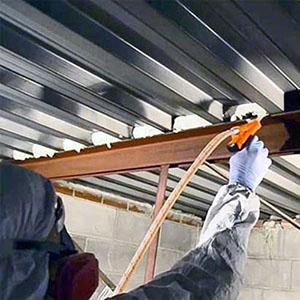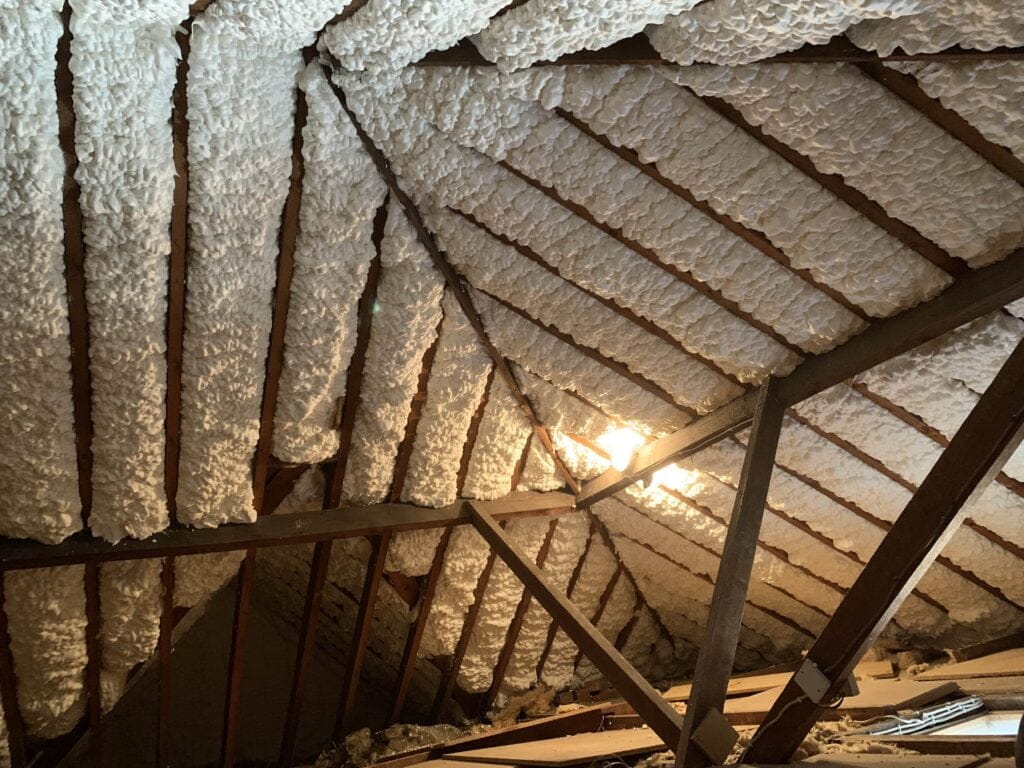The Process of Using Spray Foam: What You Required to Know
The Process of Using Spray Foam: What You Required to Know
Blog Article
Spray Foam: The Ultimate Solution for Air Sealing and Insulation
Spray foam insulation has become a leading service for reliable air sealing and thermal insulation, using an unique mix of homes that establish it aside from typical techniques. Its ability to increase and fill up voids makes it particularly efficient in protecting against air leakage, which can significantly affect energy efficiency. Comprehending the full scope of its benefits, installation procedures, and comparisons with various other insulation kinds is vital for making informed choices. As we explore these aspects, the effects for both brand-new constructions and retrofits come to be increasingly considerable. What factors should influence your option?
What Is Spray Foam?
Spray foam is a functional insulation material that incorporates the concepts of air securing and thermal resistance to boost energy effectiveness in structures. Made up primarily of polyurethane or other similar compounds, spray foam is applied as a fluid that broadens upon contact with surface areas, producing a strong, constant layer of insulation. This distinct property allows it to fill voids, cracks, and spaces that typical insulation materials may ignore, offering an exceptional air seal.
There are 2 major kinds of spray foam: open-cell and closed-cell. Open-cell spray foam is lighter and much more adaptable, supplying superb noise absorption and a reduced R-value per inch - Spray Foam. On the other hand, closed-cell spray foam is denser, offering a greater R-value, moisture resistance, and added architectural stability to constructing elements
The application process usually includes customized equipment, making sure a seamless application that follows different substratums, consisting of wood, steel, and concrete. This adaptability makes spray foam suitable for both new constructions and retrofitting existing frameworks. Its capability to produce a closed obstacle substantially adds to decreasing energy intake and boosting interior air top quality, therefore making it a recommended selection among home owners and building contractors alike.
Benefits of Spray Foam Insulation
Among the most substantial benefits of spray foam insulation is its phenomenal ability to create a constant air obstacle, which efficiently reduces energy loss. Unlike standard insulation materials, spray foam expands to fill up spaces and splits, ensuring that air leakage is dramatically reduced. This particular not only improves energy performance yet likewise leads to decrease utility expenses with time.
In addition, spray foam insulation provides superior thermal resistance, adding to a more secure interior atmosphere. Its high R-value per inch enables efficient insulation in confined rooms, making it excellent for attic rooms, wall surfaces, and crawl areas. The moisture-resistant residential or commercial properties of spray foam aid prevent mold and mold development, promoting much healthier living conditions.
An additional critical advantage of spray foam insulation is its sound-dampening top qualities (Spray Foam). It effectively decreases noise transmission in between rooms, producing a quieter and extra comfortable home atmosphere. The durability of spray foam additionally attracts attention, as it does not sag or settle with time, preserving its performance throughout its life expectancy
How Spray Foam Works
Recognizing exactly how spray foam insulation functions is crucial for valuing its effectiveness in air securing and thermal resistance. Spray foam insulation is composed of 2 key elements: isocyanate and polyol material. When these parts are mixed, they undertake a chemical response that causes the material to increase quickly, developing a dense foam that fills up gaps, cracks, and dental caries.
As the foam increases, it sticks to surfaces, creating an impermeable seal that substantially decreases air infiltration. This characteristic makes spray foam insulation very efficient at protecting against drafts and moisture infiltration, which can result in power loss and damage in time. In addition, the closed-cell variant of spray foam supplies premium thermal resistance because of its stiff structure, effectively lessening warmth transfer.
The distinct residential or commercial properties of spray foam enable it to adapt uneven surfaces, making certain detailed coverage and a smooth obstacle. As an outcome, spray foam insulation not only enhances power performance however also adds to boosted interior air top quality by reducing the buildup of toxins and allergens. Ultimately, understanding the technicians behind spray foam emphasizes its duty as a remarkable choice for insulation and air sealing in both go to my blog commercial and residential applications.
Installation Process Summary

Prior to installation, the area should be effectively cleaned and prepped, making sure that surfaces are without dust, dampness, and particles. Since impurities can compromise adhesion and overall performance, this step is vital. Once the area is prepared, the application entails mixing both components of the spray foam, which increases upon contact and fills gaps efficiently.
Educated specialists should conduct the setup, utilizing specific equipment to make certain uniform insurance coverage and optimal density. Safety preventative measures, including using safety gear and making sure proper air flow, are important throughout this procedure. After application, the foam typically treatments quickly, forming a strong barrier that improves power performance.
Contrasting Spray Foam to Conventional Insulation
When examining insulation choices, spray foam insulation stands out in comparison to traditional products such as fiberglass and cellulose. One of the key benefits of spray foam is its superior air sealing capacities. Unlike fiberglass and cellulose, which can allow air infiltration, spray foam expands upon application, filling up gaps and gaps to create an impermeable seal. This results in enhanced power efficiency, as much less heated or cooled air gets away the home, leading to reduced utility expenses.
Furthermore, spray foam supplies a greater R-value per inch than typical insulation kinds, providing even more efficient thermal resistance in a thinner profile. This particular is especially beneficial in spaces with minimal tooth cavity depth. Spray foam is immune to moisture and mold and mildew development, which can be a significant problem with cellulose and fiberglass, particularly in moist environments.
Nevertheless, spray foam insulation typically carries a greater ahead of time cost than its traditional equivalents. Homeowners need to evaluate this initial financial investment against lasting energy savings and efficiency benefits. Inevitably, while both insulation types serve their objective, spray foam arises as an advanced option for modern insulation requirements, especially in regards to air sealing and thermal efficiency.

Final Thought
In summary, spray foam insulation represents a very reliable remedy for achieving optimum air securing and thermal resistance. Its special properties, including moisture resistance and audio dampening, make it appropriate for various applications in both new buildings and retrofitting projects (Spray Foam). Although the first costs may be higher compared to conventional insulation materials, the long-lasting benefits, such as substantial power cost savings and enhanced indoor air quality, warrant the investment and emphasize its worth in modern-day structure methods.
Spray foam insulation has emerged as a leading remedy for effective air securing and thermal insulation, using an unique combination of homes that set it apart from traditional methods.Spray foam is a versatile insulation product that combines the concepts of air sealing and thermal resistance to enhance energy efficiency in go to this site structures.When examining insulation alternatives, spray foam insulation stands out in comparison to conventional materials such as fiberglass and cellulose. Inevitably, while both insulation kinds offer their objective, spray foam emerges as a much more sophisticated remedy for modern insulation demands, especially in terms of air securing and thermal effectiveness.
In recap, spray foam insulation represents a very reliable service for accomplishing optimal air securing and thermal over here resistance.
Report this page